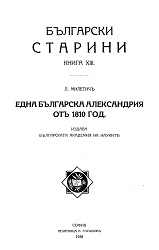
ЕДНА БЪЛГАРСКА АЛЕКСАНДРИЯ ОТЪ 1810 ГОД.
Published in 1936 by the Bulgarian Academy of Sciences (Department for History and Philology) as vol 13 of the series "Bulgarian Old Age" (БЪЛГАРСКИ СТАРИНИ, КНИГА XIII)
More...We kindly inform you that, as long as the subject affiliation of our 300.000+ articles is in progress, you might get unsufficient or no results on your third level or second level search. In this case, please broaden your search criteria.

Published in 1936 by the Bulgarian Academy of Sciences (Department for History and Philology) as vol 13 of the series "Bulgarian Old Age" (БЪЛГАРСКИ СТАРИНИ, КНИГА XIII)
More...
The present study is a primary effort to identify and decript the identitary dynamics of the two most ancient ethnic communities of Romania, the Turks and Tatars. As a context framing, the paper shows the historic and demographic evolution of the Turks and the Tatars all throughout the 20th century. Chronologically, the emphasys falls upon the communist period, to better envisage the way in which political, economic and social changes in the era were reflected in the ethnic and religious structures of the Turks and the Tatars in Dobrogea and consequently to extend on identitary evolutions after 1990. By adding the archive research to journalistic text analysis and field research (interviews, participative observation), the study traces the memory patterns of the communist period, the types of relations and attitudes created in relation to the regime, together with the evolution of self-image and image of the other (Turk-Tatar), generated by the main identitary landmarks: ethnicity, religion, origins, mother tongue and traditions, inside the socialist society as well as after the fall of the communism.
More...
U rujnu 1994. godine tadašnji dalmatinski župan Kruno Peronja, član HDZ-a, poslao je općinskim načelnicima interni dekret čiji je sadržaj bio sljedeći: „Pošto dobijete potrebito stručno mišljenje, temeljem istog na sjednici Vašeg poglavarstva donesite odgovarajuće odluke o skidanju spomen ploča i obilježja s javnih mjesta, te sukladno dobijenom stručnom mišljenju, njihovom sklanjanju u odgovarajuće prostore radi svjedočenja o vremenu koje je, na sreću, iza nas. Poglavarstva za tu namjenu trebaju osigurati sredstva za pokriće troškova skidanja i sklanjanja u namijenjene prostore, te odrediti poduzeće, radnju ili djelatnika koji će za te poslove biti ovlašteno te ih obaviti najkasnije do 31. listopada 1994.“
More...
Ako postoji nešto što je suvremena Hrvatska patentirala kao vlastiti izum, s čitavim nizom inovacija, to je obračun s neželjenom spomeničkom baštinom. Jasna stvar je da neželjenu spomeničku baštinu predstavljaju u prvom redu spomenici posvećeni Narodnooslobodilačkoj borbi, potom oni koji se odnose na baštinu Srba u Hrvatskoj, zatim oni koji na bilo koji način slave jugoslavensku ideju te na koncu oni posvećeni lijevoj tradiciji i ljudima s ljevice. Ukoliko je pak riječ o kombinaciji dva ili više navedenih faktora, što je prilično čest slučaj, takvi se spomenici uklanjaju s dodatnim guštom. Povod za nastanak ovog teksta su dva aktualna slučaja. Prvi, u kojem je HDZ-ov načelnik ličke općine Perušić, koristeći sumanute i kontradiktorne izgovore, odlučio iz središnjeg gradskog parka ukloniti partizanski spomenik, koji je ujedno kosturnica, zbog navodne rekonstrukcije parka i pretvaranja istog u dječje igralište, s idejom da ga premjesti na zabačenu lokaciju. Drugi se odnosi na Zadar, u centru kojeg je, ako ste sumnjali, u sklopu projekta rekonstrukcije parka upravo uklonjen spomenik osnivanju prve ćelije KPJ u tom gradu, ovdje pak s idejom gradonačelnika da se spomenik smjesti u muzej.
More...
Articles, pictures and interviews can be reprinted only with the consent of the publisher.
More...
Articles, pictures and interviews can be reprinted only with the consent of the publisher.
More...